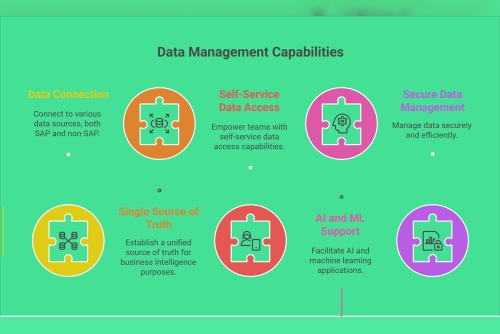Major TakeawaysWhy not use general AI models for go-to-market?General models lack business context. GTM needs domain-specific AI trained on real sales and marketing data to drive outcomes like pipeline, conversions, and product-market fit.What makes Landbase’s GTM-1 Omni unique?It’s trained on 40M+ B2B campaigns, uses agentic AI to automate GTM workflows, and continuously learns from results, delivering 4–7x better performance than traditional methods.How do teams use GTM Superintelligence today?With VibeGTM, teams articulate their GTM objectives in natural language, and AI agents autonomously handle targeting, content creation, and campaign execution. This accelerates speed to market, reduces costs, and enhances performance, all while preserving human oversight.
Superintelligence is in the spotlight. Major AI labs—from OpenAI and Anthropic to Meta's newly launched Superintelligence Labs—are racing to build general-purpose models that exceed human capabilities across reasoning, coding, and cognition. But while they aim to conquer science, math, and language, there's one critical business area being overlooked: go-to-market.
At Landbase, we're pioneering a different kind of superintelligence—one that's domain-specific and built entirely around business growth. We call it GTM Superintelligence.
Why GTM Needs Its Own SuperintelligenceGeneral-purpose models are trained on internet-scale data, but they lack the context and performance feedback loops necessary to drive meaningful GTM outcomes. You can't prompt your way to product-market fit, and you can't brute force your way to pipeline without understanding brand trust, ICP nuance, or message-market resonance. This fundamental limitation is why domain-specific AI models are increasingly outperforming general models in specialized applications.
That's why we built GTM-1 Omni—the world's first AI model trained specifically on GTM data and real performance outcomes. Pre-trained on over 40 million B2B campaigns and sales interactions, 24 million companies, 220 million contacts, and 10 million signals and events, GTM-1 Omni is reinforced with feedback from millions of campaigns and outcomes across buyers, sellers, and messaging contexts. It's purpose-built to not just assist—but outperform.
We've already seen it deliver 4-7x better performance than traditional outbound approaches when paired with high-quality input data and aligned brand strategy. It's not just machine intelligence—it's superintelligent go-to-market, a system that learns, improves, and scales beyond human limits.
The Superintelligence Context: From General to Domain-SpecificThe race for artificial superintelligence (ASI) has intensified dramatically in 2025. Mark Zuckerberg announced Meta's massive investment of hundreds of billions of dollars to build several multi-gigawatt AI data centers for superintelligence1. Meta has formed Superintelligence Labs, poaching top AI talent with offers reportedly reaching $200 million over four years—100x that of their peers.
OpenAI CEO Sam Altman has declared that "humanity has crossed into the era of artificial superintelligence" and that his company is "beginning to turn its attention to superintelligence in the true sense of the word". He describes superintelligence as systems that could "massively accelerate scientific discovery and innovation well beyond what we are capable of doing on our own".
However, this rush toward general superintelligence overlooks a critical insight: specialized AI consistently outperforms general-purpose models in domain-specific applications. While tech giants chase the holy grail of AGI, the real business value lies in vertical AI solutions that understand industry-specific contexts, workflows, and success metrics.
Gartner has validated this shift toward domain specialization, recognizing that agentic AI with domain-specific models represents the next frontier of AI innovation. In their recent emerging technology reports, Gartner highlights that AI applications with domain-specific models, like Landbase's GTM-1 Omni for go-to-market, will be able to outperform performance metrics within specialized use cases. The research giant projects that by 2030, 90% of GenAI-enabled solutions will utilize domain-specific language models (DSLMs), up from just 5% in 2025.
What Makes GTM Superintelligence DifferentUnlike the broad, internet-trained models being developed by major AI labs, GTM Superintelligence takes a fundamentally different approach:
Domain-Specific Training: GTM-1 Omni is trained exclusively on B2B sales and marketing data, giving it deep contextual understanding of what drives business outcomes. This specialized approach mirrors successful vertical AI implementations across industries, where domain-specific models consistently deliver superior accuracy and performance.
Multi-Agent Architecture: Rather than relying on a single monolithic model, GTM-1 Omni deploys specialized AI agents that work together—Strategy agents that analyze market signals, SDR agents that craft personalized messaging, and RevOps agents that optimize campaign performance. This orchestrated approach represents what Landbase calls "agentic AI"—systems that can independently plan and execute complex workflows with minimal human intervention.
Continuous Learning Loop: Unlike general models that are trained once and deployed, GTM-1 Omni continuously learns from campaign outcomes, feeding success and failure data back into its models to improve targeting and messaging over time. This creates a feedback loop that makes the system increasingly effective for each user and domain.
Real-World Performance Data: The model isn't just trained on text—it learns from the outcomes of over 40 million actual B2B campaigns, understanding not just what messages to send, but which approaches drive meetings, deals, and revenue.
The Applied AI Lab: Where GTM Superintelligence is BornIn March 2025, Landbase launched the first Applied AI Lab specifically dedicated to advancing GTM automation. Led by Chief Data Scientist Hua Gao and staffed with world-class AI and ML experts from Stanford, Meta, and NASA, the lab focuses on three critical areas:
Planning and Decisioning Models: AI that orchestrates workflows across multiple tools, utilizing private knowledge to determine optimal campaign strategies.
Generator Models: Systems that create hyper-personalized messaging tailored for omni-channel campaigns, understanding both industry context and individual prospect needs.
Prediction and Reward Models: AI that scores content and predicts prospect perception, improving conversion rates while reducing irrelevant outreach.
This lab approach represents a fundamental shift from the broad AI research happening at major tech companies to laser-focused, application-specific intelligence development.
VibeGTM: Making Superintelligence AccessibleJust as vibe coding democratized software development by allowing developers to describe what they want in natural language and let AI handle the implementation , VibeGTM brings the same "describe what you want, AI does the work" philosophy to go-to-market execution.
With VibeGTM, powered by GTM-1 Omni, marketing and sales teams can describe their target audience and goals in plain English, and the platform's AI agents autonomously plan, generate, and execute multi-channel campaigns to reach those targets. Build prospect lists, generate tailored content, and launch campaigns in under 20 minutes—not months.
This represents a paradigm shift from traditional automation, which executes predefined workflows, to true agentic AI that actively makes decisions, generates content, and optimizes strategies based on results. It doesn't just follow instructions—it learns and adapts like an autonomous team member.
The Catch: Human Agency Still MattersWhile the world rushes to build AI agents that act autonomously, we believe the future of GTM isn't just autonomous—it's agentic. The distinction is critical:
AI agents can take actionYou—the human—retain agency over what's deployedBrand trust, timing, and taste still require human judgment. Superintelligence doesn't mean removing the human—it means giving you a machine-powered advantage that scales your judgment, augments your performance, and helps you reclaim your day.
What GTM Superintelligence Looks Like in PracticeThe results speak for themselves. Companies using Landbase's GTM superintelligence experience:
4-7x conversion uplift compared to manual, human-built campaignsCampaign launch times reduced from 14 days to minutes80% cost reduction compared to traditional approachesThis isn't theoretical—it's happening now. AI that recommends campaigns based on past wins, messaging that adapts to audience behavior in real-time, execution that orchestrates omni-channel outreach autonomously, and results that are measurable, repeatable, and improving every day.
The Market Recognizes the ShiftThe investment community is taking notice. In June 2025, Landbase raised $30 million in Series A funding co-led by Sound Ventures (Ashton Kutcher's AI-focused fund) and Picus Capital. The funding round reflects growing recognition that the future belongs to vertical AI solutions rather than horizontal general-purpose models.
As Guy Oseary, Co-Founder of Sound Ventures, noted: "Landbase makes one of the hardest parts of building a business feel simple. They're not just solving outbound—they're building the foundational platform for how modern companies grow".
The broader market is aligning with this thesis. CB Insights' 2025 AI 100 report highlighted that "vertical AI is on the rise, with this year's vertical winners surpassing the other category winners to capture over $1B in combined funding in 2025 YTD". Industry experts predict that vertical AI markets could be "five to ten times larger through the introduction of artificial intelligence".
Superintelligence is Here, Domain-FirstWhile OpenAI, Meta, and Google chase the dream of general superintelligence that may still be years away, GTM Superintelligence is already delivering transformative results today. It's not about waiting for AGI—it's about building domain-specific intelligence that exceeds human performance in the areas that matter most for business growth.
Superintelligence isn't just a research goal—it's a practical opportunity when built domain-first, reinforced with real data, and grounded in human agency. At Landbase, we're not trying to replace humans. We're helping them outperform—with GTM superintelligence as their competitive edge.
This represents more than just another point solution or CRM plugin. It's a full-stack GTM system where your software doesn't just support your workflow—it becomes the driver of it. In an era where general AI promises everything to everyone, GTM Superintelligence delivers something far more valuable: AI that actually understands your business and makes you money.
The superintelligence revolution is here. The question isn't whether it will transform go-to-market—it's whether you'll be leading that transformation or reacting to it.












